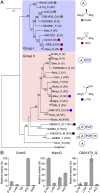Discovery of the leinamycin family of natural products by mining actinobacterial genomes
- PMID: 29229819
- PMCID: PMC5748217
- DOI: 10.1073/pnas.1716245115
Discovery of the leinamycin family of natural products by mining actinobacterial genomes
Abstract
Nature's ability to generate diverse natural products from simple building blocks has inspired combinatorial biosynthesis. The knowledge-based approach to combinatorial biosynthesis has allowed the production of designer analogs by rational metabolic pathway engineering. While successful, structural alterations are limited, with designer analogs often produced in compromised titers. The discovery-based approach to combinatorial biosynthesis complements the knowledge-based approach by exploring the vast combinatorial biosynthesis repertoire found in Nature. Here we showcase the discovery-based approach to combinatorial biosynthesis by targeting the domain of unknown function and cysteine lyase domain (DUF-SH) didomain, specific for sulfur incorporation from the leinamycin (LNM) biosynthetic machinery, to discover the LNM family of natural products. By mining bacterial genomes from public databases and the actinomycetes strain collection at The Scripps Research Institute, we discovered 49 potential producers that could be grouped into 18 distinct clades based on phylogenetic analysis of the DUF-SH didomains. Further analysis of the representative genomes from each of the clades identified 28 lnm-type gene clusters. Structural diversities encoded by the LNM-type biosynthetic machineries were predicted based on bioinformatics and confirmed by in vitro characterization of selected adenylation proteins and isolation and structural elucidation of the guangnanmycins and weishanmycins. These findings demonstrate the power of the discovery-based approach to combinatorial biosynthesis for natural product discovery and structural diversity and highlight Nature's rich biosynthetic repertoire. Comparative analysis of the LNM-type biosynthetic machineries provides outstanding opportunities to dissect Nature's biosynthetic strategies and apply these findings to combinatorial biosynthesis for natural product discovery and structural diversity.
Keywords: combinatorial biosynthesis; genome mining; leinamycin; natural products discovery; structural diversity.
Conflict of interest statement
The authors declare no conflict of interest.
Figures





Similar articles
-
Characterization of LnmO as a pathway-specific Crp/Fnr-type positive regulator for leinamycin biosynthesis in Streptomyces atroolivaceus and its application for titer improvement.Appl Microbiol Biotechnol. 2016 Dec;100(24):10555-10562. doi: 10.1007/s00253-016-7864-2. Epub 2016 Oct 5. Appl Microbiol Biotechnol. 2016. PMID: 27704182 Free PMC article.
-
P450-Catalyzed Tailoring Steps in Leinamycin Biosynthesis Featuring Regio- and Stereoselective Hydroxylations and Substrate Promiscuities.Biochemistry. 2018 Aug 21;57(33):5005-5013. doi: 10.1021/acs.biochem.8b00623. Epub 2018 Aug 2. Biochemistry. 2018. PMID: 30070831 Free PMC article.
-
Discovery of Cryptic Largimycins in Streptomyces Reveals Novel Biosynthetic Avenues Enriching the Structural Diversity of the Leinamycin Family.ACS Chem Biol. 2020 Jun 19;15(6):1541-1553. doi: 10.1021/acschembio.0c00160. Epub 2020 Apr 29. ACS Chem Biol. 2020. PMID: 32310633
-
Challenges and opportunities for natural product discovery, production, and engineering in native producers versus heterologous hosts.J Ind Microbiol Biotechnol. 2019 Mar;46(3-4):433-444. doi: 10.1007/s10295-018-2094-5. Epub 2018 Nov 13. J Ind Microbiol Biotechnol. 2019. PMID: 30426283 Free PMC article. Review.
-
Nature's combinatorial biosynthesis and recently engineered production of nucleoside antibiotics in Streptomyces.World J Microbiol Biotechnol. 2017 Apr;33(4):66. doi: 10.1007/s11274-017-2233-6. Epub 2017 Mar 4. World J Microbiol Biotechnol. 2017. PMID: 28260195 Review.
Cited by
-
Menthyl esterification allows chiral resolution for the synthesis of artificial glutamate analogs.Beilstein J Org Chem. 2021 Feb 24;17:540-550. doi: 10.3762/bjoc.17.48. eCollection 2021. Beilstein J Org Chem. 2021. PMID: 33727977 Free PMC article.
-
Recent Advances in Discovery of Lead Structures from Microbial Natural Products: Genomics- and Metabolomics-Guided Acceleration.Molecules. 2021 Apr 27;26(9):2542. doi: 10.3390/molecules26092542. Molecules. 2021. PMID: 33925414 Free PMC article. Review.
-
Targeted Large-Scale Genome Mining and Candidate Prioritization for Natural Product Discovery.Mar Drugs. 2022 Jun 16;20(6):398. doi: 10.3390/md20060398. Mar Drugs. 2022. PMID: 35736201 Free PMC article. Review.
-
A multiproducer microbiome generates chemical diversity in the marine sponge Mycale hentscheli.Proc Natl Acad Sci U S A. 2020 Apr 28;117(17):9508-9518. doi: 10.1073/pnas.1919245117. Epub 2020 Apr 14. Proc Natl Acad Sci U S A. 2020. PMID: 32291345 Free PMC article.
-
Thiocysteine lyases as polyketide synthase domains installing hydropersulfide into natural products and a hydropersulfide methyltransferase.Nat Commun. 2021 Sep 28;12(1):5672. doi: 10.1038/s41467-021-25798-8. Nat Commun. 2021. PMID: 34584078 Free PMC article.
References
-
- Newman DJ, Cragg GM. Natural products as sources of new drugs from 1981 to 2014. J Nat Prod. 2016;79:629–661. - PubMed
-
- Shen B. Polyketide biosynthesis beyond the type I, II and III polyketide synthase paradigms. Curr Opin Chem Biol. 2003;7:285–295. - PubMed
-
- Fischbach MA, Walsh CT. Assembly-line enzymology for polyketide and nonribosomal peptide antibiotics: Logic, machinery, and mechanisms. Chem Rev. 2006;106:3468–3496. - PubMed
-
- Walsh CT. The chemical versatility of natural-product assembly lines. Acc Chem Res. 2008;41:4–10. - PubMed
-
- Cane DE, Walsh CT, Khosla C. Harnessing the biosynthetic code: Combinations, permutations, and mutations. Science. 1998;282:63–68. - PubMed
Publication types
MeSH terms
Substances
Grants and funding
LinkOut - more resources
Full Text Sources
Other Literature Sources
Molecular Biology Databases

